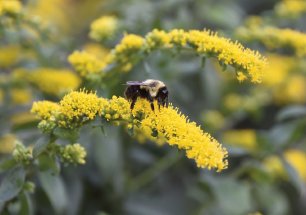Goldenrod can be a good garden addition
One of the sights I look forward to each year is goldenrod in full bloom.
Beginning in late August and peaking about the third week of September, goldenrods seem to be along the roadsides of every highway and in in every natural area and field. The masses of bright yellow are gorgeous, and it’s hard for me to consider the goldenrod as a weed.
While I think of goldenrods as gorgeous and welcome, many people consider them to be the scourge of the fall allergy season. That belief is actually not true. Goldenrod is the victim of cause-and-effect reasoning: If your fall allergies peak when goldenrods are blooming all around, then it must be plant’s fault.
However, the real culprit is the ragweed that blooms at the same time. We don’t see these tiny, inconspicuous flowers, but they produce loads of small pollen grains that are easily distributed by the wind. Ragweed pollen wreaks havoc with the allergies of thousands of people.
I have said many times that many of our flowering ornamental plants are only one or two steps out of the ditch. Goldenrod is the perfect example of this line of thought.
Now, I will admit I probably wouldn’t plant the “wild-type” goldenrod in my home garden because it would be a wee bit too invasive. Wild goldenrods tend to be 4-foot-tall, unbranched plants. While the flower heads are arching, the plants themselves usually have a top heavy appearance.
I have noticed goldenrods blooming on shorter plants along highways, but these were probably mowed down in late spring.
An older selection that has an outstanding flowering habit is Fireworks goldenrod, which grows to 3 to 4 feet tall and wide. This plant naturally branches close to the ground, and flower clusters radiate out in all directions from these arching branches.
In full flower, these plants resemble yellow sparks streaming outward from exploding fireworks.
There are goldenrod selections under evaluation that have shorter and denser growth habits.
Goldenrod produces big pollen grains that require insects to transfer them from flower to flower. It’s these big pollen grains that make goldenrod one of the best pollinator-attracting plants for the fall season.

